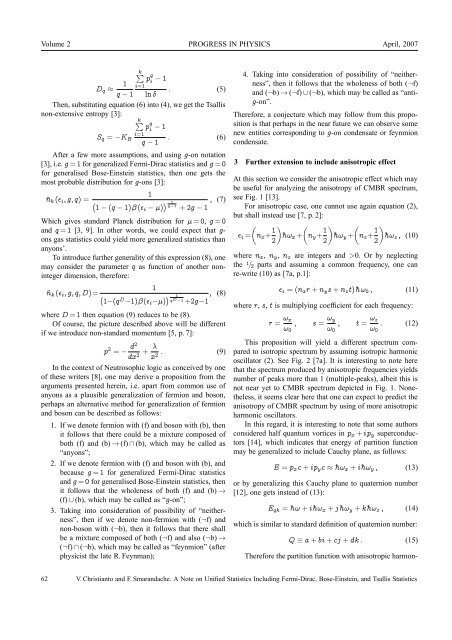ISSUE 2007 VOLUME 2 - The World of Mathematical Equations
ISSUE 2007 VOLUME 2 - The World of Mathematical Equations
ISSUE 2007 VOLUME 2 - The World of Mathematical Equations
Create successful ePaper yourself
Turn your PDF publications into a flip-book with our unique Google optimized e-Paper software.
Volume 2 PROGRESS IN PHYSICS April, <strong>2007</strong><br />
Dq ≈ 1<br />
k�<br />
p<br />
i=1<br />
q − 1<br />
q<br />
i − 1<br />
. (5)<br />
ln δ<br />
<strong>The</strong>n, substituting equation (6) into (4), we get the Tsallis<br />
non-extensive entropy [3]:<br />
k�<br />
p<br />
i=1<br />
Sq = −KB<br />
q<br />
i − 1<br />
. (6)<br />
q − 1<br />
After a few more assumptions, and using g-on notation<br />
[3], i.e. g = 1 for generalized Fermi-Dirac statistics and g = 0<br />
for generalised Bose-Einstein statistics, then one gets the<br />
most probable distribution for g-ons [3]:<br />
1<br />
ˉnk (ɛi, g, q) = � � 1 , (7)<br />
q−1 1 − (q − 1)β (ɛi − μ) + 2g − 1<br />
Which gives standard Planck distribution for μ = 0, g = 0<br />
and q = 1 [3, 9]. In other words, we could expect that gons<br />
gas statistics could yield more generalized statistics than<br />
anyons’.<br />
To introduce further generality <strong>of</strong> this expression (8), one<br />
may consider the parameter q as function <strong>of</strong> another noninteger<br />
dimension, therefore:<br />
1<br />
ˉnk (ɛi, g, q, D)= �<br />
1−(qD−1)β(ɛi−μ) � 1<br />
qD −1 +2g−1<br />
, (8)<br />
where D = 1 then equation (9) reduces to be (8).<br />
Of course, the picture described above will be different<br />
if we introduce non-standard momentum [5, p. 7]:<br />
p 2 = − d2<br />
dx<br />
λ<br />
+ . (9)<br />
2 x2 In the context <strong>of</strong> Neutrosophic logic as conceived by one<br />
<strong>of</strong> these writers [8], one may derive a proposition from the<br />
arguments presented herein, i.e. apart from common use <strong>of</strong><br />
anyons as a plausible generalization <strong>of</strong> fermion and boson,<br />
perhaps an alternative method for generalization <strong>of</strong> fermion<br />
and boson can be described as follows:<br />
1. If we denote fermion with (f) and boson with (b), then<br />
it follows that there could be a mixture composed <strong>of</strong><br />
both (f) and (b) → (f) ∩ (b), which may be called as<br />
“anyons”;<br />
2. If we denote fermion with (f) and boson with (b), and<br />
because g = 1 for generalized Fermi-Dirac statistics<br />
and g = 0 for generalised Bose-Einstein statistics, then<br />
it follows that the wholeness <strong>of</strong> both (f) and (b) →<br />
(f) ∪ (b), which may be called as “g-on”;<br />
3. Taking into consideration <strong>of</strong> possibility <strong>of</strong> “neitherness”,<br />
then if we denote non-fermion with (¬f) and<br />
non-boson with (¬b), then it follows that there shall<br />
be a mixture composed <strong>of</strong> both (¬f) and also (¬b) →<br />
(¬f) ∩ (¬b), which may be called as “feynmion” (after<br />
physicist the late R. Feynman);<br />
4. Taking into consideration <strong>of</strong> possibility <strong>of</strong> “neitherness”,<br />
then it follows that the wholeness <strong>of</strong> both (¬f)<br />
and (¬b) → (¬f) ∪ (¬b), which may be called as “antig-on”.<br />
<strong>The</strong>refore, a conjecture which may follow from this proposition<br />
is that perhaps in the near future we can observe some<br />
new entities corresponding to g-on condensate or feynmion<br />
condensate.<br />
3 Further extension to include anisotropic effect<br />
At this section we consider the anisotropic effect which may<br />
be useful for analyzing the anisotropy <strong>of</strong> CMBR spectrum,<br />
see Fig. 1 [13].<br />
For anisotropic case, one cannot use again equation (2),<br />
but shall instead use [7, p. 2]:<br />
ɛi =<br />
�<br />
nx+ 1<br />
2<br />
� �<br />
ˉhωx + ny+ 1<br />
� �<br />
ˉhωy + nz+<br />
2<br />
1<br />
�<br />
ˉhωz , (10)<br />
2<br />
where nx, ny, nz are integers and >0. Or by neglecting<br />
the 1/2 parts and assuming a common frequency, one can<br />
re-write (10) as [7a, p.1]:<br />
ɛi = (nxr + nys + nzt)ˉhω0 , (11)<br />
where r, s, t is multiplying coefficient for each frequency:<br />
r = ωx<br />
, s =<br />
ω0<br />
ωy<br />
, t =<br />
ω0<br />
ωz<br />
. (12)<br />
ω0<br />
This proposition will yield a different spectrum compared<br />
to isotropic spectrum by assuming isotropic harmonic<br />
oscillator (2). See Fig. 2 [7a]. It is interesting to note here<br />
that the spectrum produced by anisotropic frequencies yields<br />
number <strong>of</strong> peaks more than 1 (multiple-peaks), albeit this is<br />
not near yet to CMBR spectrum depicted in Fig. 1. Nonetheless,<br />
it seems clear here that one can expect to predict the<br />
anisotropy <strong>of</strong> CMBR spectrum by using <strong>of</strong> more anisotropic<br />
harmonic oscillators.<br />
In this regard, it is interesting to note that some authors<br />
considered half quantum vortices in px + ipy superconductors<br />
[14], which indicates that energy <strong>of</strong> partition function<br />
may be generalized to include Cauchy plane, as follows:<br />
E = px c + ipy c ≈ ˉhωx + iˉhωy , (13)<br />
or by generalizing this Cauchy plane to quaternion number<br />
[12], one gets instead <strong>of</strong> (13):<br />
Eqk = ˉhω + iˉhωx + jˉhωy + kˉhωz , (14)<br />
which is similar to standard definition <strong>of</strong> quaternion number:<br />
Q ≡ a + bi + cj + dk . (15)<br />
<strong>The</strong>refore the partition function with anisotropic harmon-<br />
62 V. Christianto and F. Smarandache. A Note on Unified Statistics Including Fermi-Dirac, Bose-Einstein, and Tsallis Statistics

















